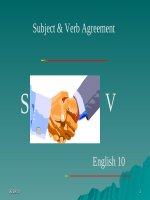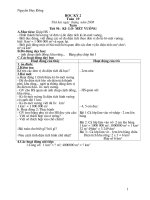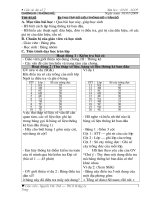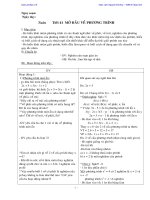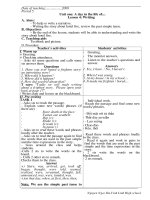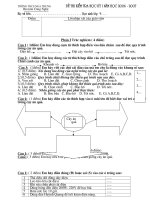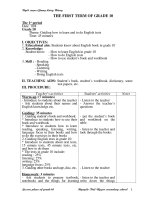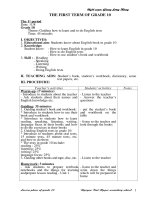GIÁO ÁN ANH 10 KỲ 2 - 2010
Bạn đang xem bản rút gọn của tài liệu. Xem và tải ngay bản đầy đủ của tài liệu tại đây (215.23 KB, 40 trang )
Unit 9: undersea world
Date of preparing: …. / …. / 2008
I/ Aim
• Theme: Undersea world
• Pronounciation
• Grammar:
- Should
- Conditional type 2
II/ Teaching aids: Cards; posters, realthings, pictures.
III/ Division of the unit
Period 1: Reading
Period 2: Speaking
Period 3: Listening
Period 4: Writing
Period 5: Language focus
Unit 9 Undersea world Period 55
Period 1: reading Date of teaching: …/…/2008
I. Objectives.
By the end of the lesson, Ss will be able to know more about the life of sea animals and
oceans in the world.
- Through the unit , Sts will have the sense of protecting sea environment .
II. Materials
Textbook, A map of the world
III. Anticipated problems.
Ss may not know much about the marine life.
Time Steps Work
arrangement
5’
Warm up
- Sts close their books .
- T asks the Ss to think out some sea animals and write them
in the card board ( Suggested answers: shark, dolphin, whale,
crab, seal, salmon, jellyfish, …)
- T introduces new lesson: To understand more clearly about
sea animals and their environment, today we’re going to
study lesson 1: Reading
Pair work
Before you read
- Ss close their books and answer the teacher’s questions:
1) Can you name the oceans in the world?
2) Write names of the following sea animals: se…, je…, tu…,
sh….
- T asks Sts to write the names of the Oceans on the board
Whole class
10’
without correcting them at once.
- Ss work in pairs to fill in the blanks.
- T go round to help .
- T correct the information in front of the class.
(T may open his book to show the pictures of some animals
and the map).
Answer keys:
- - Arctic Ocean : BBD - An arctic Ocean : NBD
- Pacific Ocean : TBD - Atlantic Ocean : DTD
- Indian Ocean : ADD
Answer keys:
+ seal (n) + jellyfish (n)
+ turtle (sea turtle) (n) + shark (n)
Vocabulary :
- gulf (n)
- challenge (v)/(n)
- submarine (n):
- investigate (v) :
Investigation (n)
- provide (v) s.o with s.th, s.th for s.o
provision (n)
- tiny (a) : extremely small
- organism (n)
- biodiversity (n) :
10’
While you read
- Ss open their books and read in silent by following the
cassette recorder once to practise new words.
Task 1:
- Ss read in individual for three minutes.
- T remind Ss of finding 8 words from the reading.
- Ss tell the parts of speech of these words.
- Ss skim to find out necessary information.
- Ss interchange in pairs.
- T goes round to check.
- Ss fill in the blanks.
Answer keys:
1. tiny
2. investigate
3. gulf
4. biodiversity
5. samples
Individual work
10’
Task 2: (10ms)
- Ss read the questions.
- Ss read in individual and find out information from the
passage.
- Ss interchange in pairs.
- T corrects them before the class.
Answer keys:
1) 75% of the earth’s surface.
2) By using modern devices
3) They investigate the seabed and bring samples of
marine life back to the surface for further study.
4) We can know a wide range of information, including
water temperature, depth and the undersea populations.
5) They are those that live on or depend on the bottom like
the starfish, those that move independently of water currents
and those that are carried along by the currents.
6) Marine life would be at stake if the sea biodiversity were
not maintained
Pair work
6'
After you read
- Sts work in pairs to skim over the reading.
- T suggests and asks Sts to do what he tells.
- T corrects them before the class.
Answer keys:
1) three-quarter 2) mysterious
3) modern 4) discoveries
5) biodiversity 7) plants & animals
6) huge 8) closely connected
Pair work
Wrapping
Summarise the main points.
Assign homework.
================================
Unit 9 Undersea world Period 56
Period 2: speaking Date of teaching: …/…/2008
I. Objectives.
By the end of the lesson, Ss will be able to
- Offer solutions to sea problems using should / shouldn't, talk about causes and
consequences of sea problems.
II. Materials
Textbook, pictures
III. Anticipated problems.
Ss may have difficulty in knowing some words in this section.
IV. Procedure
Time Steps Work
arrangement
5’
Warm up
- Sts close their books .
- T asks the Ss to answer the following questions:
1) What will you do if there is a lot of rubbish and
plastic bags in our class?
2) How will our environment be if there is too much
rubbish in our class?
3) What things do you think make the sea dirty ?
Suggested answers:
1) We should put them in dustbins.
2) It will be polluted.
3) They are rubbish, plastic bags, oil spilled from
tankers, pesticides from the field,…
- T introduces new lesson: Today we’re going to practice
speaking about the ways to protect sea environment.
Group work
7'
PRE-SPEAKING:
- T explains the new words, structures and expressions
for Ss to interchange in pairs.
- Ss study them by learning their meanings and repeating
after T.
Vocabulary:
- - sparingly(adv)
- - dispose of (v)
- - herbicide(n)
- - endangered (a)
- - smart shopper:
-
Whole class.
- Structure: SHOULD(NOT) + V1
8’
WHILE SPEAKING:
Task1:
- Ss open their books and read carefully the request of
task 1.
- Ss work in pairs to put the actions in the order of
importance and say what they should or shouldn’t do.
- T goes round to help .
- T may suggests them by asking questions:
1) In your opinion, which action should you do to
protect oceans at first? Which one is the most important
?
2) Which action shouldn’t you do?
Expressions:
- What do you think of/ What’s your opinion of (using
herbicides, fishing for species, being a smart shopper,…)
- Well, I think…
- - In my opinion,….
-As far as I concerned,… .
Pair work
10'
Task 2:
- T shows the chart in the card board and gives the
threats in advance.
- Ss Practice in groups to find out the consequences and
the solutions .( each group must have a secretary )
- T goes round to help them or gives the meanings of
new words. (if any )
- Ss fill in the chart.
Threats Consequences Solutions
1. Beaches filled with
plastic
1. 1.
2. Whales hunted for
food
2. 2.
3. Explosives used to
catch fish
3. 3.
4. Oil spilled from
tankers
4. 4.
5. Pesticides blown
off the fields into the
sea
5. 5.
Pair work
12’
POST-SPEAKING:
Task3:
- Ss work in groups to give their opinions about the
ways to protect sea environment.
- T asks one S of each group to report to the class what
his group has discussed.
- T corrects these reports before class.
Group work
3’
Wrapping
Summarise the main points.
Assign homework: Learn by heart new words, structures
and expressions. Make 5 sentences about the protecting
of the sea, using the structure “We should/ shouldn’t…”
* Remark:
- Time is too short.
Whole class
===================================
Unit 9 Undersea world Period 57
Period 3: listening Date of teaching:…./…/2008
I. Objectives
By the end of the lesson, Ss will be able to
- listen for specific information about whales.
II. Materials
Textbook,cassette…
III. Anticipated problems
Ss may not know much about whales.
IV. Procedure.
Time Steps Work arragement
5'
Warm up
- Ss close their books .
- T shows the chart, containing 2 columns A and B.
- Ss fill in the chart with what they should do or shouldn’t
do to protect sea animals.
- T introduces new lesson: Today we’re going to listen
about whales: their length and weight, their feeding
ground and food & the reason for protecting them.
What we should do What we shouldn’t do
1.
2.
1.
2.
Group work
3. 3.
10'
Before you listen
Activity 1:
- Ss practice in pairs,asking and answering these two
questions:
1. Do you think whales are fish? Why(not)?
2. Why do people keep hunting whales?
Suggested answers:
1.Whales are not fish because they raise their young on
milk.
2. Because they want to catch whales for food, oil, leather
and other products
- T lets Ss read the words ( will appear) in the tape script,
pay attention to the way of pronunciation and the
meanings (if any).
- Ss read these words in silent.
- T corrects them before the class.
Activity 2: Listen and repeat
-mammal (n): animals that give birth to live babies and
feed their young on milk.
-krill(n): tiny shellfish
- migrate(v): move from one place to live in another
-decrease(v) ≠ increase(v)
Pair work
8'
While you listen
Task 1:
- T asks Ss to read the sentences given and underline the
important words.
- T explains the sentences that Ss don’t understand.
- T turns on the cassette player twice.
- Ss work in individual.
- T asks Ss to answer and correct them
. Answer keys:
1. F 2. T 3. T 4. F 5. T
Individual work
10'
Task 2:
- T asks Ss to read these 6 questions in advance and find
out important words.
- T suggests some main expressions:
The length and weight.
Why - feed in the cold ocean.
What- good feeding grounds.
What-main reasons- decrease whale population.
What happen- didn’t take any measures to protect.
- T turns on the cassette player twice.
- Ss work in groups to discuss and prepare.
-While listening, good Ss can repeat the whole answer,
bad Ss can repeat one word they’ve listened.
Suggested answers:
1. The blue whale grows to 30 meters in length and over
200 tons in weight .
2. Because there is a lot of krill-their favorite food in
cold water.
3. Cold water in the North and South Atlantic Ocean and
the North and South Pacific are their good feeding
grounds .
4. Heavy hunting is the main reason for the decrease in
whale population .
5. They have asked International Whaling commission to
stop most whaling .
6. If we didn t take any measures to protect whales, ’
whale would disappear forever .
Group work
10'
after you listen
Task3:
- Ss work in groups to share the information they’ve
listened about whales:
+ their length and weight
+ their feeding grounds and food
+ the reasons for protecting whales
- T asks one S of each group to report to the class what his
group has discussed.
- T corrects these reports before class.
Group work
2'
Wrapping
Summarise the main points
Assign homework : - Learn by heart new words, rewrite
some whales’ special features.
- Prepare “ Writing”.
* Remark:
Whole class.
==============================
Unit 9 Undersea world Period 58
Period 4: writing Date of teaching: …./…../2008
I. Objectives
By the end of the lesson, Ss will be able to
- write a descriptive paragraph about dolphins by using the facts and figures from
the table.
II. Materials
Textbook,
III. Anticipated problems
Ss may not be familiar with some words in the model.
IV. Procedure.
Time Steps Work
arragement
5'
Warm up
- Sts close their books .
- T asks the Ss to play jumbled words:
PRMES, EAHLWS, REA, THE, IGSTEGB, NMLSAIA,
NO, ERHTA, HTAT, HVEA,ETHET.
Suggested answers:
Sperm whales are the biggest animals on earth that have
teeth
- T introduces new lesson: Today we’re going to study about
the sperm whales and dolphins & their special features.
Group work
10'
Before you write
Task 1:
Activity 1:
- T explains the new words and expressions.
- Ss open their books and read in silent the description.
Vocabulary:
- sperm whale
- carnivore (n)
- diet (n): food
- male (n)/ (a) ≠ female (n)/(a)
- calf (n): young sperm whale
- trap (n ) entrap (v) entrapment (n)
- gestation (n)
- due to +V-ing
- squid (n):
- off spring:
Pair work
10'
While you write
Task1:
Activity 2:
- Ss work in groups to fill in the table( page 100).
- T walks round to help .
-.T may suggest them by asking questions:
1) Where can sperm whales be found?
2) Which water do they prefer?
3) Would you tell me the length and the weight of a
male /female whale?
4) What do they eat?
5) How long is a gestation period?
6) How many years can whales be?
7) What are their special features?
8) Why should people be concerned about endangered
whales?
- T corrects these information before class.
Suggested answers:
Range &
Habitat
All Oceans
Prefer waters with high squid populations
Size
Mafe:18m in length : 54.000 kg in weight
Femafe:12m in length :17.000 kg in
Individual work
Group work
Unit 9 Undersea world Period 59
Period 5: Language focus Date of teaching: …./…./2008
I. Objectives
By the end of the lesson, Ss will be able to
- pronounce correctly three diphthongs /iə/, /eə/, /uə / in separate words and in speeches.
- use Should and Conditional type 2 appropriately.
II. Materials
Textbook, whiteboard markers…
III. Anticipated problems
IV. Procedure.
Time Steps Work arragement
5'
Warm - up
- Sts close their books .
- T divides the class into 2 groups and lets the Ss to
play a game: Group A write the If –clause and group
B write the main clause(each desk must have a clause).
Then T collects them and chooses any If –clause and
any main clause to make conditional sentences.
- T corrects and introduces new lesson: Today we’re
going to study SHOULD and conditional
sentence( type 2) after practicing the three
diphthongs /iə/, /eə/, /uə /.
Whole class
10'
Pronunciation
Activity 1: Listen and repeat
- Ss listen to the cassette player these 3 diphthongs
(once) to realize the difference among them.
- Ss repeat after T once.
- T write their phonetic symbols on board and numbers
them: (1)/iə /; (2)/eə /; (3)/uə /.
-Ss close their books and speak aloud the number of
the sound T reads.
Activity 2: Practice these sentences
- Ss listen and repeat after T twice.
- Ss practice reading these sentences
- T walks round to help .
Individual
Pair work
10'
Grammar and vocabulary
* Should:
Activity 1: (Exercise 1- Page 102)
- Ss read the example carefully.
- T explains the structure with SHOULD.
- Structure: SHOULD(NOT) + V1
Expressions:
I think/ I don’t think+ S + should + V1
-Ss practice in pairs.
- T walks round to help .
-.T may suggests them by asking questions:
1) What would you do if you were Jack?
2) What should you do?
-Each S reads his sentence before the class.
Suggested answers:
2 - (My salary is very low)
- You should look for another job.
3 - Jack always has difficulty getting up)
- He shouldn’t go to bed so late .
4 - (What a beautiful view!)
- You should take a photograph.
5 - (Sue drives every where. She never walks)
- She shouldn’t use her car so much.
6 - (Bill’s room isn’t very interesting)
- He should put some pictures on the wall .
whole class
15'
* Conditional sentence type 2:
Activity 3: (Exercise 3- Page 103)
- T presents the structure of conditional sentence type
2.
-T tells Ss the difference between type1 and type 2,
then asks Ss to give examples.
Structure:
Conditional sentence type 2 :Unreal in the present
If clause Main clause
S + V2/ V-ed
(were)
S +Would/should…+V1
- Ss practice in groups.
- T walks round to help .
-One S of each group reads his sentence before the
class.
Suggested answers:
3. If I was offered the job, I think I would take it .
Pair work
4. I’m sure Amy will lend you the money, I’d very
surprised if she refused.
5. If I sold may car, I would not get much money for it
6. A lot of people would be out of work if the factory
closed down.
7. What would happen if I pressed that red button ?
8. Liz gave me this ring. She would be very upset if I
lost it .
9. Mark and carol are expecting us. They would be
disappointed if we did not come .
10. Would Tim mind if I borrowed his bicycle without
asking him ?
11. If somebody walked in here with a gun . I’d be
very frightened .
12. I’m sure Sue would understand if you explained the
situation to her .
Whole class.
5'
Wrapping
Summarise the main points
Assign homework :
* Remark:
Unit 10: conservation
Date of preparing: ……. / ……….. / 2008
I/ Aim
• Theme: Conservation
• Pronounciation : / b / - / p /
• Grammar:
- The passive voice
II/ Teaching aids: Cards; posters, real things, pictures.
III/ Division of the unit
Period 1: Reading
Period 2: Speaking
Period 3: Listening
Period 4: Writing
Period 5: Language focus
Unit 10 : conservation Period 60
Period 1: reading Date of teaching:…/…./2008
I. Objectives
By the end of the lesson, Ss will be able to
- Contribute their parts to the protection of the natural environment.
II. Materials
Textbook, whiteboard markets,………
III. Anticipated problems
Ss may not know much about conservation, so T should be ready to help them.
IV. Procedure.
Time Steps Work arragement
5'
WARM UP
- Sts close their books .
- T asks the Ss to think out some environmental
problems and write them in the card board.
- T introduces new lesson by asking questions:
What is conservation?
Conservation is the protection of natural things, such
as plants and animals.
Group work
Environmental
problems
Suggested answers:
-the extinction of the plants and animals
- pollution, floods, droughts, volcanic eruption , earth
quakes, forest fire,…
10'
Before you read
Activity 1:
- Ss work in pairs to look at the picture in page 104 and
answer the questions1,2,3 in this page.
- T goes round to help .
- T correct the information in front of class.
Activity 2:
- T delivers handouts and tells Ss the way to do.
- Ss work in pairs to fill in the blanks in the table of
word form.
- T goes round to help .
- T corrects the information before class.
Noun Verb
1. ? protect
2. ? destroy
3. pollution ?
4. damage ?
5. conservation ?
6. ? disappear
Suggested answers:
1. protection 4. damage
2. destruction 5. conserve
3. pollute 6. disappearance
Vocabulary :
- eliminate (v)
- circulation (n)
- run-off (n)
- hydroelectric (n)
Pair work
Pair work
7'
While you read
Task 1:
- Ss open their books and read in silent by following
the cassette recorder once to practice new words.
-Ss scan quickly the reading to find out the new words
in column A. Ss work in individual, then interchange in
pairs.
- T goes round to help Ss to guess the meanings of the
new words in the context.
Answer keys of task1:
Individual work
7'
7'
1. C 2. A 3. D 4. B
Task 2 :
- Ss read the text in silence and do the task 2.
- Ss read the given statements, T explains new words (if
any)
- Ss skim to find out necessary information to identify if
they are T or F.
- Ss interchange in pairs.
- T goes round to check.
- T corrects the information before class.
Answer keys of task 2:
1. F 2. T 3. T 4. T 5. F 6. F
Task 3:
- Ss work in groups of every desk to find the information
in the reading, then choose the main idea for each
paragraph.
- T explains that the main idea of each paragraph often
appears in the topic sentence.
Answer keys of task 3:
*Paragraph A :
Main idea : Forests give us a lot of valuable things .
Topic sentence : many of those plants and animals
can be used as medicine against cancer, AIDs…, heart
diseases and many other sicknesses .
*Paragraph B :
Main idea :We can not live without water. Topic
sentence : Man and most animals need a constant supply
of water to live .
*Paragraph C :
Main idea : Lets do something to save the earth .
Topic sentence : The earth is being threatened and the
future looks bad . What can each of us do ?
Individual work
and Pairwork
Group work
7'
after you read
- Sts work in groups to find the answers in the reading to
prove the importance of forests, water and have the
emergent actions to conserve .
- T goes round to check.
- T corrects them before the class.
Answer keys:
1. The loss of much forests is destroying the earths.
Group work
